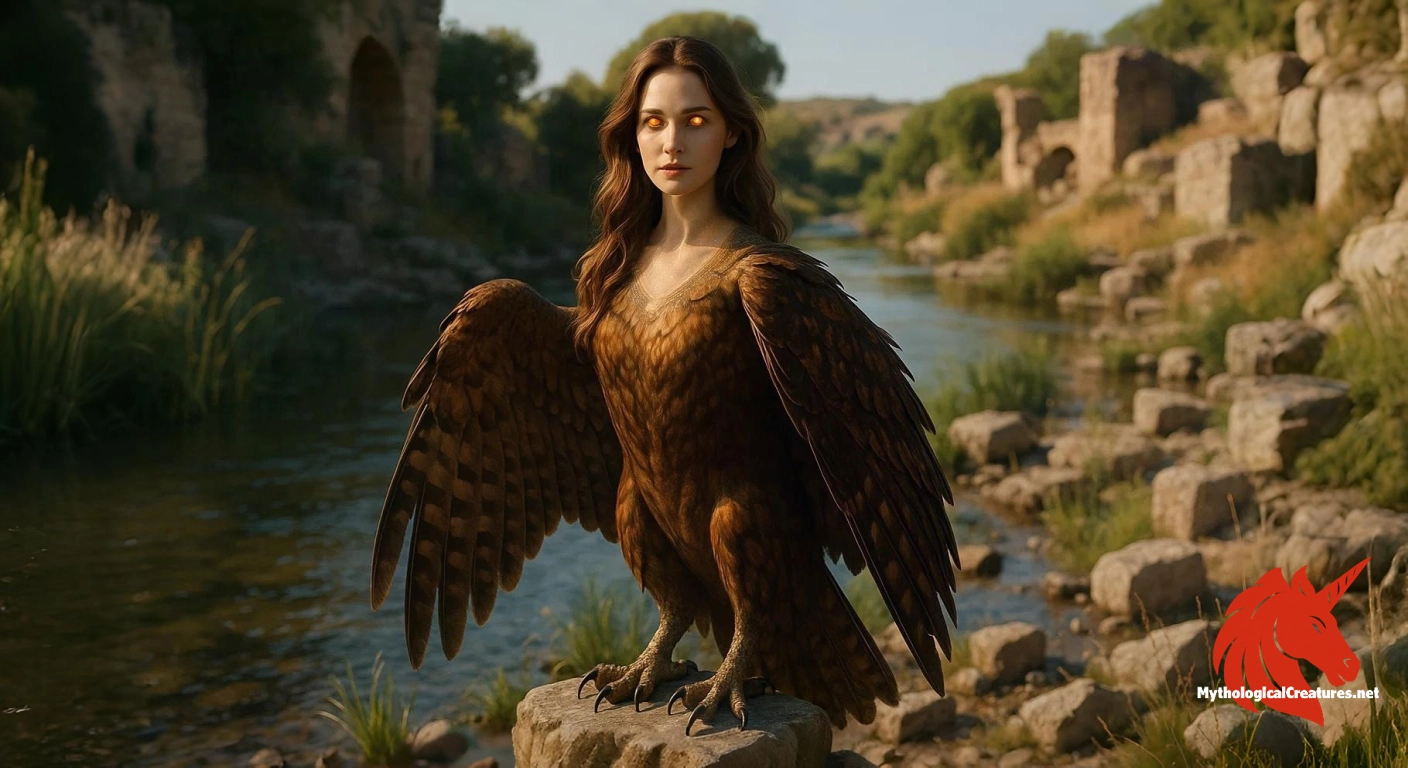Sirin: Sirin is a mythological creature from Russian legends, depicted with the head of a beautiful woman and the body of an owl.

Sirin
Sirin - Sirin embodies the duality of beauty and danger, symbolising the unpredictable forces of fate in myth.
Origins & First Encounters
Sirin emerges in Russian myth as a captivating, dual-natured creature, merging the grace of a human with the mystique of a bird. Her head, reminiscent of an exquisite maiden, is portrayed with delicate features that evoke both charm and a subtle melancholy. The creature’s body, modelled on the sturdy form of an owl, represents a deep connection to the ancient realms of nature. This synthesis of human beauty and untamed avian spirit has fascinated storytellers for centuries. Although her legend draws significant inspiration from the Greek siren, Sirin has evolved into a distinct icon within Russian folklore. Early references to her are preserved in oral traditions, where rich narratives were passed down through generations. Her myth interlaces themes of seduction and forewarning, symbolising the perilous interplay between allure and danger. She is frequently associated with mystical landscapes such as Iriy and the banks of the Euphrates, which add an exotic dimension to her tale. These evocative settings enhance the symbolic depth of her legend. Over time, Sirin has come to encapsulate the timeless dialogue between beauty and menace, resonating with audiences across eras.
Source Texts & Tale Variants
Ancient manuscripts and folk ballads serve as the primary records of Sirin’s lore, even though they offer only fragmented glimpses into her enigmatic presence. The creature’s tale survives partly in the oral traditions of rural Russia, where poetic retellings imbue her with both irresistible allure and an undercurrent of warning. Medieval codices occasionally reference her, juxtaposing her image with the Greek siren while adapting her character to local sensibilities. Artistic embellishments in religious texts further allude to her ethereal beauty, hinting at a symbolic complexity beneath her outward charm. Certain folktales amplify her role beyond seduction, casting her as a spectral herald who portends misfortune. Numerous versions of her story exist, each varying in detail as they navigate the boundary between myth and moral lesson. In poetic anthologies, Sirin’s eerie song and mesmerising visage recur as motifs that evoke both danger and fascination. Local storytellers have enriched her narrative by integrating regional colour and context into her myth. The diversity of these sources creates a multifaceted tapestry that underscores the evolving nature of her legend. By drawing on disparate textual and oral traditions, Sirin’s lore continues to exemplify the enduring power of myth across cultures and epochs.
Form & Powers
Sirin is vividly portrayed with the head of a beautiful, enigmatic woman whose features radiate both grace and a lingering sadness. Her eyes are often described as deep and captivating, mirroring untold tales of ancient sorrow and seductive promise. The gentle contours of her face stand in sharp contrast to the robust, avian form that characterises the rest of her body. Her flowing hair is sometimes depicted as merging seamlessly with soft plumage, symbolising a harmonious blend of human and natural essence. The wings that extend from her back are rendered in exquisite detail, suggesting the elevated mystery of the skies. Her plumage, typically illustrated in muted, nocturnal hues interspersed with subtle iridescence, contributes to her mystical reputation. In some portrayals, the integration of her human visage with the formidable body of an owl underscores her dual capacity to be both beguiling and dangerous. Artistic renderings accentuate the contrast between her inviting expression and the enigmatic, talon-adorned limbs of her bird form. Every feather is depicted with meticulous care, serving as a metaphor for the intricate narrative of beauty interlaced with latent menace. Through these detailed physical attributes, Sirin embodies the fusion of delicate allure and formidable natural power.
Regional Faces
Across different regions, the myth of Sirin acquires a unique local flavour as her narrative adapts to diverse cultural landscapes. In the heart of Russian folklore, she is predominantly cast as an ethereal presence whose beauty is intermingled with an ominous portent. Eastern European variants often portray her as a mournful spirit whose song carries both enchantment and a sense of inevitable sorrow. In Near Eastern retellings, particularly those linked to the Euphrates and the legendary land of Iriy, her character adopts an exotic allure that intertwines with ancient Mesopotamian myth. Some regional adaptations accentuate her dual identity, transforming her into both a seductive figure and a custodian of hidden wisdom. Local artistic renditions frequently incorporate indigenous symbols, reflecting the historical and environmental contexts unique to each area. Her portrayal shifts subtly from one locale to another, capturing the tension between life and death, beauty and peril. In rural narratives, Sirin is sometimes woven into the fabric of seasonal cycles and natural rhythms, inspiring local rituals and traditions. These regional variations underscore how her fundamental qualities remain constant despite differing cultural embellishments. Ultimately, Sirin stands as a multifaceted emblem whose legend is enriched by the vivid hues of local myth and tradition.
Cultural Parallels
Sirin’s mythic structure invites a wealth of cultural comparisons, most notably with the classical Greek siren from whom she partly derives. Whereas Greek sirens are predominantly associated with the perilous allure of the sea, Sirin’s realm is more terrestrial and suffused with enigmatic beauty. Her dual depiction as both an entrancing seductress and a harbinger of doom finds parallels in numerous mythologies across the Mediterranean and Eastern Europe. The interplay of human and animal elements in her form is a recurring motif that resonates in diverse cultural traditions. Her ability to enchant through song is a trait shared with various legendary beings, linking her to broader themes of beauty intertwined with peril. Comparative analysis reveals that while the Greek siren’s narrative centres on the seduction of mortal men, Sirin embodies a more complex balance between allure and admonition. Similar hybrid creatures emerge in lesser-known folklores, suggesting a widespread human fascination with the union of beauty and danger. Her story serves as a canvas onto which universal themes are projected, drawing connections across geographically disparate traditions. The cross-cultural parallels underscore the enduring appeal of transformative beings who defy conventional categorisation. In juxtaposing Sirin with her mythological counterparts, one discovers a rich tapestry of symbolic resonances that traverse regional and cultural boundaries.
Legacy & Modern Evolution
Throughout history, Sirin’s myth has evolved from a shadowy warning in ancient folklore to a richly layered symbol in modern cultural narratives. Her image has been reinterpreted over the centuries, reflecting shifting societal values and the evolving aesthetics of mythic storytelling. Contemporary literature often reimagines her as a multifaceted figure who embodies both the allure of unfulfilled desire and the ominous presence of impending loss. Modern artworks capture her dual nature by blending elements of romance, melancholy, and the supernatural to evoke a timeless beauty. Film and digital media have introduced Sirin to new audiences, transforming her traditional role into one that resonates with current themes of empowerment and existential reflection. Her enduring legacy as a symbol of the tension between seductive allure and latent danger is continually rediscovered and re-evaluated. Literary reinterpretations cast her as an emblem of both inspiration and caution, drawing on centuries of metaphorical depth. The evolution of her character mirrors broader shifts in cultural perspectives, as ancient myths are recontextualised to address contemporary questions. In both academic circles and popular discourse, Sirin is celebrated not only for her mythic origins but also for her capacity to encapsulate enduring cultural contrasts. Thus, her journey from obscure legend to modern icon illustrates the timeless vitality of myth and its ability to adapt, inspire, and provoke thoughtful reflection.
Interesting Fact
An intriguing aspect of Sirin is its dual cultural origin, merging Russian folklore with influences from ancient Greek mythology, highlighting the cross-cultural exchanges in myth-making.
Quick Creature Info
Our Mythic Legendary Rating:

Habitat:
Supernatural Powers:
Physical Attributes:
Abilities:
Behavior:
Lore:
Related Creatures, Tales or Lore
- AAlkonost
- SSiren (Greek)
References
Discover Another Mythical Legend You May Not Have Heard Of?
Uncover the mysteries of ancient folklore and expand your knowledge of legendary beings from cultures around the world.
Dare to Meet the Bakotsu....
Mythical Disclaimer: The images and data on this site are derived from various historical and literary sources, but we have found that many myths often have multiple versions and interpretations across references, sometimes contradictory. As a result, these creature depictions are artistic interpretations—imaginative blends of folklore, legend, and a dash of AI guesswork. Because creature descriptions vary widely, our illustrations and accompanying information represent our best effort to honor mythology while bridging creative gaps. Enjoy these interpretations—just remember, we've done our best to respect the stories and validate available data, but in the realm of mythology, details often shift, imagination leads the way, and nothing is ever set in stone!
Curated by the Mythological Creatures Team (rev. May 2025)
